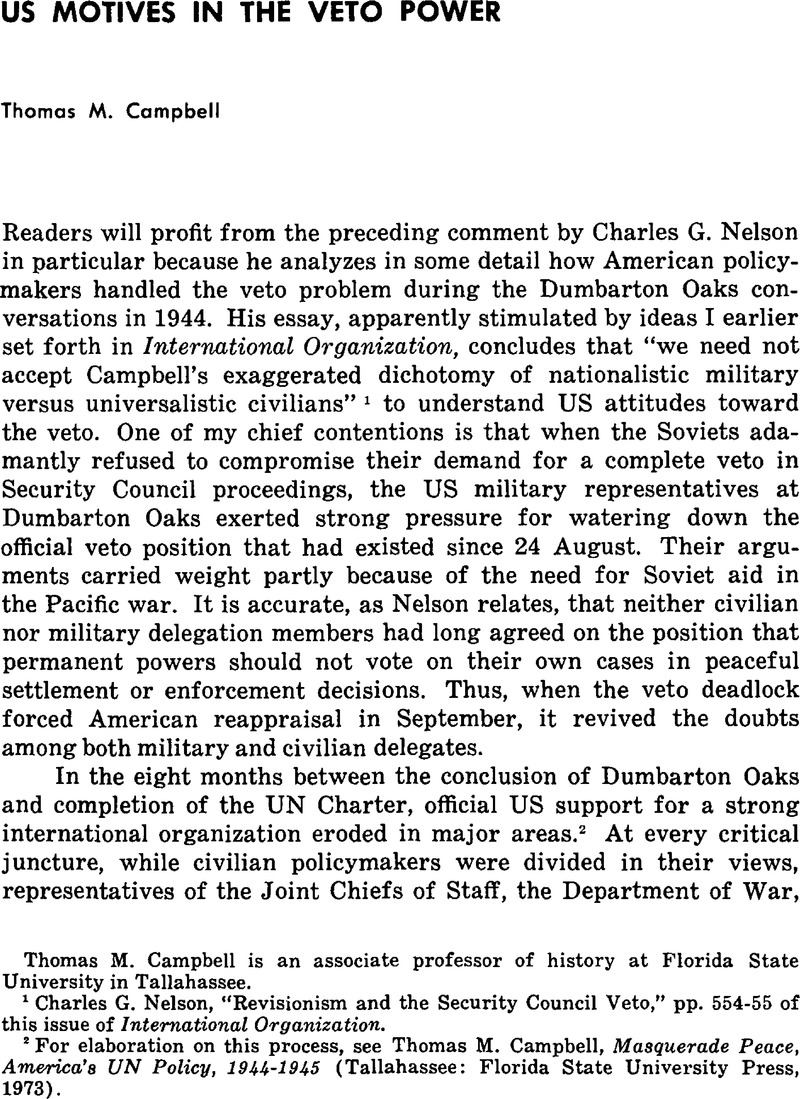No CrossRef data available.
Article contents
US Motives in the Veto Power
Published online by Cambridge University Press: 22 May 2009
Abstract

- Type
- Comments and Current Views
- Information
- Copyright
- Copyright © The IO Foundation 1974
References
1 Charles G. Nelson, “Revisionism and the Security Council Veto,” pp. 554–55 of this issue of International Organization.
2 For elaboration on this process, see Campbell, Thomas M., Masquerade Peace, America's UN Policy, 1944–1945 (Tallahassee: Florida State University Press, (1973).Google Scholar
3 These men were ambassador to the USSR, assistant secretary of state for American Republic's Affairs, undersecretary of state, and senator (Republican from the state of Michigan), respectively.
4 While the Department of State acquiesced to a request from the Joint Chiefs to postpone discussion of trusteeship matters at Dumbarton Oaks, it advocated a strong UN trusteeship system into the spring of 1945.
5 Nelson, p. 540.
6 Nelson, pp. 541–42. On 25 August Hull met with Senate leaders to brief them on changes in the US position. The next two days embraced the weekend. These factors, rather than lack of a decision, is why the matter was not discussed at Dumbarton Oaks until 28 August. For the White House discussion of 24 August, see US Department of State, General Records, Lot 60 D224, Memo for the President, 23 August 1944, Box 55, National Archives; Stettinius, calendar notes, supplementary notes on conversation with the President, 24 August 1944, The Stettinius, Edward R. Jr., Papers, University of Virginia, Charlottesville; Cordell Hull, The Memoirs of Cordell Hull, vol. 2 (New York: The MacMillan Company, 1948), pp. 1677–78.Google ScholarHull, Vandenberg, Connally, et al., memorandum of conversation, 25 August 1944, The Cordell Hull Papers, Library of Congress, Washington, D.C.
7 Nelson, pp. 545–46. Regardless of Roosevelt's vacillation on aspects of UN policy, he counted on its success to help assure cordial relations between the great powers after the war. See Burns, James MacGregor, Roosevelt: The Soldier of Freedom, 1940–1945 (New York: Harcourt-Brace-Jovanovich, 1970), pp. 548–52.Google Scholar
8 Stettinius, Dumbarton Oaks Diary, 19 September 1944, Stettinius Papers.
9 Stettinius, calendar notes on meeting with Truman, 23 May 1945, Stettinius Papers; Joint Chiefs of Staff, “Instructions for the Guidance of the U.S. Military Advisers at the San Francisco Conference,” n.d., Stettinius Papers; McCloy to Stettinius, 3 May 1945, Stettinius Papers; Stimson-McCloy, memorandum of phone conversation, 8 May 1945, The Henry L. Stimson Papers, Sterling Library, New Haven, Connecticut; Stimson Diary, 2 May 1945, Stimson Papers; US Department of State, Foreign Relations of the United States, Diplomatic Papers, 1945, vol. 1: General: The United Nations (Washington, D.C.: US Government Printing Office, 1967), p. 547.
10 Nelson, p. 554.


